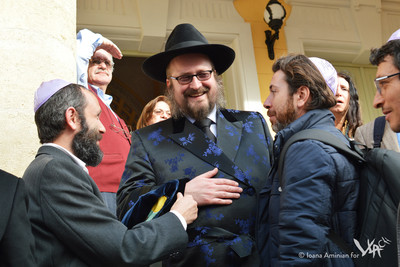
Glottocode: ladi1251, ISO 639/3: lad
The Sephardim (Hebrew: Sefaraddim ‘The Jews of Spain’), who were expelled from Spain and Portugal in 1492 and 1497 respectively, are a Jewish ethnic group distinguishable from oriental Jews (Hebrew: Bene HaMizrah ‘Sons of the East’) and the predominantly Ashkenazim in Central and Eastern Europe. The three branches of Judaism differ in both the way they interpret Judaism, rites, customs, and folklore, and also in the languages they speak.
On July 31, 1492, the last Jews who had not converted to Christianity left the realm of the Catholic Monarchs, Queen Isabella I of Castile and King Ferdinand II of Aragon. Around 12,000 Jews fled to the Kingdom of Navarre from which they were expelled again after seven years. Most of them later fled to Portugal, Italy and North Africa or, following an invitation from Sultan Bayazid, to the Ottoman Empire.
Settlements represented in our collection
READ MORE...
READ MORE...
According to historians, at the turn of the 15th and 16th centuries, between 90,000 and 400,000 Jews emigrated from Spain to the east (Kowallik 2003: 43-44). In the Ottoman Empire alone, the number of immigrant Jews was estimated at between 70,000 and 90,000. Jewish communities emerged in Constantinople, Thessaloniki, Trikala, Belgrade and Kastoria. In the Orient, Jewish centres were established in Damascus, Aleppo, Badda and Jerusalem. Additionally, Constantinople and Thessaloniki developed into significant cultural centres of Judaism, the latter being known as the "Jerusalem of the Balkans" (Bossong 2008: 93).
In the 1960s, the population of Sephardic Jews worldwide was estimated at approximately 360,000, most of whom (300,000) lived in Israel, Turkey (20,000), Greece (5,000), and the USA (15,000) (Hetzer 2004: 41). Today we count less than 17,000 in Turkey and less than 1,000 Sephardim in Greece with the number decreasing considerably every year.
Judeo-Spanish is a vanishing language, with the number of speakers worldwide estimated between 400,000 (Hetzer 2004: 237) and 11,000 (Harris 2011: 58). Since the late Middle Ages, Judeo-Spanish has developed many independent extra-linguistic as well as internal language innovations due to the constant migration of the Sephardim and the diverse language contacts in the diaspora (Kowallik 1993: 10).
The time of the birth of Judeo-Spanish dates back to the Middle Ages where, in 1492, the expulsion of the Sephardim from the Iberian Peninsula took place. The middle stage of the Judeo-Spanish development happened after their arrival in the territories of the Ottoman Empire (Turkey, Greece, Bulgaria, Yugoslavia and Romania), Israel and North Africa. The Modern Epoch began in the early twentieth century, especially following the adoption of the Ottoman laws of Tanzimât, a period of reform in the Ottoman Empire that began in 1839 and ended with the First Constitutional Era in 1876. The Modern Epoch continues to the present day (Bunis 1994: 10-11).
Hebrew, though qualitatively less representative, is the oldest and most stable element in the foundation of the Judeo-Spanish language. The other components, which may number three or four languages depending on the linguistic context, are generated by the language contact in the diaspora (Weinreich 2008: 166).
Harris (1994: 20) identified 81 glottonyms that refer to the language of the Sephardim. The endonyms also differ considerably from the exonyms. The most common denominations for Judeo-Spanish are Ladino, Judeo-Español, Judeo-Spanish, Español, Espanyol, Spanyol, Djudyo, Djudezmo, Hakitía (Morocco) etc. (Busse 1994: 8). Judeo-Spanish designates the written and spoken language of the Sephardim, while Ladino refers to the language of Bible translations. The glottonym preferred by the Sephardic elites is Judeoespanyol with the realization Judeo-Español (Busse 1994: 38). The most commonly used term outside of linguistics is Ladino, which, especially in the Anglo-Saxon world, is mistakenly used for all the colloquial vernaculars of the Sephardim. The most common self-designation of the language of the Sephardim is (es)español lo muestro (‘our Spanish’). The term Ladino is, however, gaining more and more followers among the speakers in Turkey, Israel and beyond.
Bibliography
Bossong, Georg (2008): Die Sepharden. Geschichte und Kultur der spanischen Juden, München: C.H. Beck.
Bunis, David Marc (1994): Una introduccion a la lengua de los sephardies, in: Busse, Winfried (Ed.), Judenspanisch I. Berlin: Freie Universität Berlin.
Busse, Winfried (1994): Zur Problematik des Judenspanischen, in: Busse, Winfried (Ed.), Judenspanisch I. Berlin: Freie Universität Berlin, 37-84.
Harris, Tracy K. (1994): Death of a language. The history of Judeo-Spanish. Newark: University of Delaware Press.
Harris, Tracy K. (2011): The State of Ladino Today, in: European Judaism 1, 44, 51-61.
Hetzer, Armin (2001): Judeo-español, Djudezmo. Einführung in die Umgangssprache der südosteuropäische Juden. Wiesbaden: Harrassowitz.
Hetzer, Armin (2004): Outlines of the Current State of Sephardic, in: Sobolev, A. N. / Rusakov, A. Ju. (Ed.) Языки и диалекты малых этнических групп на Балканах. Материалы междунарой научной конференции, Санкт-Петербург, 11-12 июня 2004 г. Санкт-Петербург/München: Biblion Verlag, 237-251.
Kowallik, Sabine (2003): Beiträge zum Ladino und seine Orthographiegeschichte, in: Balkan-Archiv, 28/29, Hamburg, Dissertation.
Kowallik, Sabine / Krammer, Johannes (1993): Romanojudaica. Würzburg: Wissenschaftlicher Verlag A. Lehmann.
Lleal, Coloma (1992): El dialecto sefardí y su historia. Barcelona: Universidad de Barcelona.
Münch, Almuth (1994): Die hebräisch-aramäische Sprachtradition der Sepharden in ihrem Verhältnis zum Spanischen in Sepharad I sowie zum Djudeo-espanyol in Sepharad II und die Rolles des Ladino, in: Busse, Winfried (Ed.), Judenspanisch I, Neue Romania 12, Berlin, 171-241.
Nezirović, Muhamed (2002): Judenspanisch, in: Okuka, Miloš (Ed.) Wieser Enzyklopädie: Sprachen des europäischen Ostens. Klagenfurt, 101-116.
Weinreich, Max (2008): History of the Yiddish language. New Haven: Yale Univ. Press
© Ioana Aminian 2019-2020
Video Collection
Links
The Sephardic Center (Austria)
Centropa (Austria)
Autoridad Nasionala Del Ladino (Israel)
Instituto MaaleAdumim (Israel)
OLAC Resources Ladino Language
Ottoman-Turkish Sephardic Culture Research Center (Turkey)
Casa Sepharad Israël (Spain)
Los Muestros (Belgium)
Ladinokomunita (US)
Foundation for the Advancement of Sephardic Studies and Culture (FASSAC) (US)
Aki Estamos (France)
La Lettre Sépharade (France)
eSefarad - Noticias del Mundo Sefardi (Argentina)